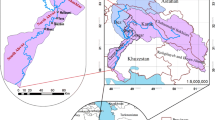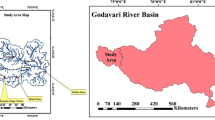Abstract
Can Tho city in the Mekong Delta is in the top ten areas affected by climate change. Therefore, assessing climate change impacts, social and economic activities require proposed solutions to respond to climate change. This study aims to (i) apply the MIKE 11 model (Hydrodynamic module and Advection–Dispersion module) to simulate the impacts of climate change scenarios on water resources in Can Tho city; (ii) calculate water balance in Can Tho city; and (iii) suggest climate change adaptation plan for sustainable social-economic activities of the city. The results show that when the rainfall changes due to climate change, the flow rate tends to decrease at high tide and increase at low tide. When the sea level rises due to climate change, the flow rate tends to increase at high tide and decrease at low tide. For 2030, the flow will decrease up to 15.6% and 14.3% at the low tide period for RCP 2.6 and RCP 8.5 compared to the present, respectively. The flow will increase up to 63.5% and 58.9% at the high tide period for RCP 2.6 and RCP 8.5 compared to the present, respectively. The water demand evaluation shows that the water resource reserve in Can Tho city meets water demands in current and future scenarios under climate change. While rainwater and groundwater can provide enough water in the rainy season, the city has to use surface water during the dry season due to a lack of rainwater. Of these, agriculture contributes the most water demands (85%). Eight adaptation measures to climate change for Can Tho city are developed from 2021 to 2050.









Similar content being viewed by others
Data availability
The datasets generated during and/or analyzed during the current study are available from the corresponding author on reasonable request.
References
Andersen, H. E., Kronvang, B., Larsen, S. E., Hoffmann, C. C., Jensen, T. S., & Rasmussen, E. K. (2006). Climate-change impacts on hydrology and nutrients in a Danish lowland river basin. Science of the Total Environment, 365(1–3), 223–237. https://doi.org/10.1016/j.scitotenv.2006.02.036
Cantho city Statistical Office. (2011). Statistical yearbook of Cantho city. Statistical Publishing House.
DHI. (2007). Reference manual MIKE 11: A modeling system for rivers and channels.
Huu-Thoi, N., & Gupta, A. D. (2001). Assessment of water resources and salinity intrusion in the Mekong Delta. Water International, 26(1), 86–95. https://doi.org/10.1080/02508060108686889
IPCC. (2013). The physical science basis. Contributing of Working Group I to the Fifth Assessment Report of the Intergovernmental Panel on Climate Change. Cambridge University Press, Cambridge, UK.
Minh, H. V. T., Tri, V. P. D., Ut, V. N., Avtar, R., Kumar, P., Dang, T. T. T., & Downes, N. K. (2022). A model-based approach for improving surface water quality management in aquaculture using MIKE 11: A case of the Long Xuyen Quadangle, Mekong Delta, Vietnam. Water (Switzerland), 14(3). https://doi.org/10.3390/w14030412
Tran, D. A., Tsujimura, M., Ha, N. T., Nguyen, V. T., Binh, D. V., Dang, T. D., & Pham, T. D. (2021). Evaluating the predictive power of different machine learning algorithms for groundwater salinity prediction of multi-layer coastal aquifers in the Mekong Delta, Vietnam. Ecological Indicators, 127, 107790. https://doi.org/10.1016/j.ecolind.2021.107790
Tran, T. Q. (2014). Climate change and sea level rise in the Mekong Delta: Flood, tidal inundation, salinity intrusion, and irrigation adaptation methods. In N. D. Thao, H. Takagi, & M. Esteban (Eds.), Coastal disasters and climate change in Vietnam (pp. 199–218). Elsevier Inc.
Van Ty, T., Thu Minh, H. V., Avtar, R., Kumar, P., Van Hiep, H., & Kurasaki, M. (2021). Spatiotemporal variations in groundwater levels and the impact on land subsidence in CanTho, Vietnam. Groundwater for Sustainable Development, 15(November 2020), 100680. https://doi.org/10.1016/j.gsd.2021.100680
Vansteenkiste, T., Tavakol, M., Ntegeka, V., Willems, P., Smedt, F. D., & Batelaan, O. (2012). Climate change impact on river flows and catchment hydrology: A comparison of two spatially distributed models. Hydrological Processes. https://doi.org/10.1002/hyp
Vo, T. N. G., Nguyen, H. T., & Phan, T. B. T. (2019). Nghiên cứu ứng dụng mô hình WEAP tính toán cân bằng nước sông Cần Thơ đến năm 2020 và 2050. Tài Nguyên và Môi Trường, 2(7/2019).
Yates, D., Sieber, J., Purkey, D., & Huber-Lee, A. (2005). WEAP21 - A demand-, priority-, and preference-driven water planning model. Part 1: Model characteristics. Water International, 30(4), 487–500. https://doi.org/10.1080/02508060508691893
Funding
This research is funded by Vietnam National University Ho Chi Minh City (VNU-HCM) under grant number NVTX TX 2021–24-01. The authors thank Vietnam National University in Ho Chi Minh for providing the fund. The authors thank the Department of Natural resources and Environment of Can Tho City for providing the data and supports.
Author information
Authors and Affiliations
Contributions
Conceptualization, BH; methodology, KN, QN, BH; data procurement: HN, BH, TN, HTN; formal analysis, KV, KD, LP, DNN; investigation, HN, BH; writing—original draft preparation, THN, HN, BH; visualization, HN; supervision, BH and QN; and project administration, KV.
Corresponding author
Ethics declarations
Conflict of interest
The authors declare no competing interests.
Additional information
Publisher's Note
Springer Nature remains neutral with regard to jurisdictional claims in published maps and institutional affiliations.
This article belongs to the Topical Collection on Environmental sustainability and impacts of climate change in the Mekong delta region.
Rights and permissions
About this article
Cite this article
Ho, B.Q., Nguyen, K.D., Vu, K.H.N. et al. Apply MIKE 11 model to study impacts of climate change on water resources and develop adaptation plan in the Mekong Delta, Vietnam: a case of Can Tho city. Environ Monit Assess 194 (Suppl 2), 765 (2022). https://doi.org/10.1007/s10661-022-10185-7
Received:
Accepted:
Published:
DOI: https://doi.org/10.1007/s10661-022-10185-7




